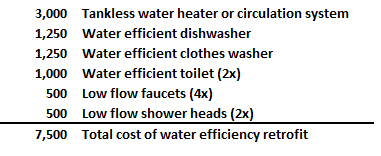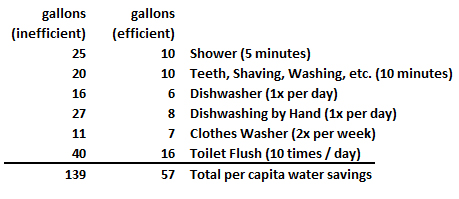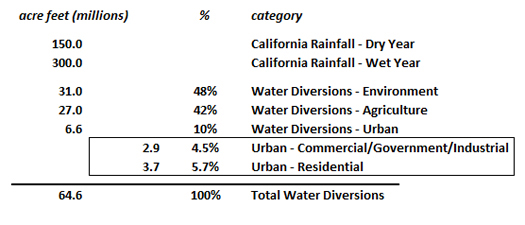Permanent Water Rationing is Coming to California
Have you experienced water faucets that spray tiny jets of water onto your hands? You know, those eight tiny jets of water, each about 1.0 millimeter in diameter, that are emitted with so much pressure that the paltry quantity of water bounces off your skin before you can get it wet enough to apply soap, and makes rinsing the soap off nearly impossible? You can find these water faucets in airports and other public places, where they constitute a minor annoyance. But wait. Thanks to California’s state legislature, they’re on their way into your home.
You’ll just love your personal space filled up with these expensive gadgets. For example, these faucets will probably require voice-activation, turn off after ten seconds, and send a report to your utility in order to help you manage your usage patterns. Smart faucets. Smart washers. Smart dish washers. Smart shower heads and smart toilets – all coming your way, thanks to the California State Legislature and their partners, the scarcity profiteers of Silicon Valley.
You’ll love how all these water-sipping, next-generation durable goods can go “down,” get hacked, don’t work very well, and require annual warranty payments. You’ll also love purchasing bargain basement annual software upgrades, but only affordable, barely, if you join their green team club for life special VIP program. You’ll love how the control panel on your washer will look like the bridge of a starship, and can only be operated after you’ve mastered the virtual version of a two-inch thick instruction manual.
California’s ruling coalition of government employee unions, extreme environmentalists, and high-tech billionaires are at it again, this time with a water conservation bill, AB 1668, that is going to impose a mandatory limit of 55 gallons per person per day on indoor water consumption. Bring on the gadgets.
To put the impact of this bill into perspective, consider what it would cost to retrofit a household to reduce indoor water consumption:
COST TO RETROFIT A HOME TO REDUCE WATER CONSUMPTION

The biggest cost on this table is the cost for a tankless water heater or a hot water circulation system, necessary if we don’t want to waste water while waiting for it to get hot. Because there’s no good solution to that problem, this is a significant source of water waste that is blithely ignored by water conservation activists. It’s reasonable to expect people in a developed, wealthy nation like America to wait until they have warm water before washing their hands, shaving, hand washing dishes, or showering. And there is no way a person is going to bring their indoor water usage down to 55 gallons a day without either performing all these tasks with cold water, or by installing a system to deliver instant hot water.
But if every Californian did their best to comply with AB 1668, could they reduce their water usage to 55 gallons per day? The next table shows how much they could save, using USGS data. Please note the USGS data is for America, not for California, where decades of conservation incentives have already yielded tremendous reductions in use. Per capita indoor water use in California isn’t anywhere near 139 gallons per day. More on that later.
PER CAPITA POTENTIAL WATER SAVINGS USING WATER EFFICIENCY APPLIANCES

Apart from water efficient toilets which save water and don’t require lifestyle changes, there’s not much here that isn’t expensive and inconvenient. Notwithstanding the fact that Silicon Valley moguls are salivating over the prospects of subsequent mandates that will require all these retrofit appliances to be “smart,” they aren’t going to make life better. Low flow shower heads require longer duration showers, especially if you have to rinse shampoo out of long hair. Consumer reports offer mixed reviews on low water consumption dishwashers and washing machines. Some of us like to wash our dishes by hand – in many cases because it’s less time consuming. And who wants to pull wet clothes out of side loading washers? As for waiting for hot water to make it to faucets, there’s no inexpensive and effective solution.
Enforcing the 55 gallon indoor limit will also be costly not only for California’s residents, but for every water utility in the state. After all, to regulate indoor water consumption, you have to measure indoor water consumption separately from outdoor water consumption. And, of course, residential outdoor water consumption is also in AB 1668’s cross hairs. To accomplish this, AB 1668 calls for dedicated outdoor water meters, separate from indoor water meters, and it calls for water utilities to prepare a water “budget” for each customer parcel based on the size of the parcel and other factors such as the local climate.
THE COST/BENEFIT OF RESIDENTIAL WATER RATIONING
Since AB 1668 proposes to effectively ration residential water consumption, at staggering expense, it’s worthwhile to explore the cost and benefit of this policy. If we assume that five million of California’s 12.5 million households still have legacy appliances, just the retrofit would cost these unlucky homeowners $37.5 billion. But it doesn’t end there, because the water utilities would have to install indoor/outdoor meters on around 10 million households (some households are in multi-family dwellings with no yard or a shared yard). Assuming the cost to install these meters and conduct site visits to assign individual outdoor “water budgets” at $1,000 per household means another $10 billion will have to be spent – i.e., implementing AB 1668 will cost $47 billion.
But how much water would actually be saved, for $47 billion? According to the most authoritative study available on current indoor water consumption, the average Californians uses 62 gallons per day. (ref. California Water Plan Update 2013 Chapter 3, page 12, 1st paragraph “Indoor Residential.”) This means that if California’s 40 million residents got their indoor water use down to 50 gallons per day from 62 gallons per day, it would save 537 thousand acre feet per year (0.54 million acre feet). This is a minute fraction, less than 1%, of California’s total water diversions for environmental, agricultural, and urban uses.
AB 1668 is not about saving water. It’s about control. It’s about power and profit for special interests. Otherwise we could just expand sewage treatment plants, which we should do anyway. How can you waste indoor water if it can go down the drain, to be treated and pumped right back up the hill for reuse?
Let’s keep this in perspective by imagining best case scenarios whereby indoor and outdoor residential water use is dramatically reduced. If Calfornia’s 40 million residents reduced their household water consumption by another 20%, it would only save 0.74 million acre feet per year. An impossible 40% reduction? Savings of 1.5 million acre feet per year. For one-tenth the cost, the proposed “off-stream” Sites Reservoir could easily capture over 2.0 million acre feet each year in storm runoff. Just one good storm dumps ten times that much water onto California’s watersheds.
TOTAL ANNUAL WATER SUPPLY AND USAGE IN CALIFORNIA

So what could Californians do instead with $47 billion? We’ve looked at this before. Limiting ourselves to water infrastructure, here’s a list:
WAYS TO CREATE WATER ABUNDANCE IN CALIFORNIA
First of all, market-based incentives can eliminate water scarcity at almost no cost. For example: Allow farmers to sell their water allotments at market rates without losing their vested rights. Or permit utilities to engage in mild price hikes that encourage people to use less water, instead of resorting to punitive tiered pricing or rationing. These alternatives, to some extent, have already been tried. They work. But if you accept the premise that increasing the absolute supply of water in California is desirable – here are the capital costs for water infrastructure that would create water abundance in California for decades to come.
- Desalinate 1.0 million acre feet of seawater – $15 billion.
- Reclaim and reuse 2.0 million acre feet of sewage – $10 billion.
- Build the Sites Reservoir for off-stream storage of 2.0 million acre feet of run-off – 4.4 billion.
- Build the Temperance Flat Reservoir for 1.3 million acre feet of storage – 3.3 billion.
- Aquifer recharge to store runoff – there isn’t even a good study exploring this option at a statewide level.
As can be seen, all of these water infrastructure projects could be built for $32.7 billion. They could be financed via infrastructure bonds, increased rates to consumers, redirection of funds currently being squandered on high-speed rail, or even redirection of proceeds from carbon emission auctions.
What California’s ruling junta prefers, however, is to create a surveillance state defined by expensive scarcity. In the 1950s and 1960s, California’s legislature approved and implemented what remains the finest system of inter-basin water transfers in the world. But today, after over 30 years of neglect, at the same time as California’s population has doubled, California’s water infrastructure is crumbling at a time when it should be expanded. The reasons for this are plain enough. Special interests have replaced the public interest.
THE SCARCITY PROFITEERS
Instead of building water infrastructure to increase supplies of water, public employee unions want to see tax revenues pour into their pockets and into the pension funds. High-tech billionaires want contracts to build “smart” appliances and monitoring systems to enforce water rationing. Extreme environmentalists, and the trial lawyers who get incredibly wealthy representing their organizations, want more legal bases upon which to file lucrative lawsuits. Sadly, major corporate agribusinesses often acquiesce to this abuse of residents because they’ve decided that a bigger slice of a smaller pie is all they can hope for from this legislature.
Until Californians realize there will be no end to these encroachments on their freedom and prosperity until they resist, California’s ruling junta will prevail. California will be a harder and harder place to live. If ordinary Californians value their freedom, they will form a coalition with farmers, energy companies, civil engineering firms, and construction unions to demand water abundance. They may rediscover the vision and leadership that built a water infrastructure that is still one of the wonders of the modern world.
REFERENCES
Assembly Bill 1668, “Water management planning” Text (Source: California Legislative Information)
https://leginfo.legislature.ca.gov/faces/billCompareClient.xhtml?bill_id=201720180AB1668
Residential Water Use in California:
Water Saving Potential of water-efficient appliances (Source: USGS)
https://water.usgs.gov/edu/activity-percapita.php
California Water Plan Update 2013 Chapter 3 – Urban Water Use Efficiency
http://www.water.ca.gov/calendar/materials/vol3_urbanwue_apr_release_16033.pdf
Cost to purchase and install various water-saving appliances:
Cost (including installation) for a tankless water heater
https://www.bankrate.com/personal-finance/cost-of-tankless-water-heater/
Cost (including installation) for a water efficient dishwasher
Cost (including installation) for a water efficient clothes washer
ps://www.homeadvisor.com/cost/kitchens/install-an-appliance/
Cost (including installation) for a low flow toilet
https://www.remodelingexpense.com/costs/cost-of-low-flow-toilets/
Total precipitation in California during wet, average, and dry years:
California Water Supply and Demand: Technical Report
Stockholm Environment Institute
Table 2: Baseline Annual Values by Water Year Type and Climate-Scenario (MAF)
http://sei-us.org/Publications_PDF/SEI-WesternWater-CWSD-0211.pdf
California water use by sector:
California Water Today
Public Policy Institute of California
Table 2.2, Average annual water use by sector, 1998–2005
http://www.ppic.org/content/pubs/report/R_211EHChapter2R.pdf
California urban water use by sector:
California Dept. of Water Resources
2010 Urban Water Management Plan Data – Tables
Download spreadsheet “DOST Tables 3, 4, 5, 6, 7a, 7b, & 7c: Water Deliveries – Actual and Projected, 2005-2035”
http://www.water.ca.gov/urbanwatermanagement/2010_Urban_Water_Management_Plan_Data.cfm
* * *
